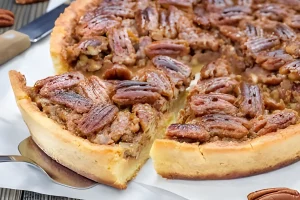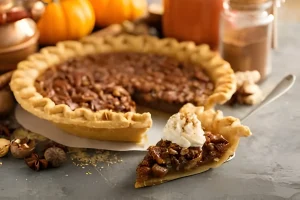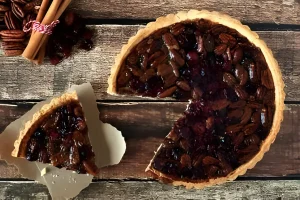In the heart of traditional American cuisine lies a sweet delight that embodies the essence of family gatherings, especially around Thanksgiving – the pecan pie. This article delves deep into the world of pecan pie, from its rich history and essential ingredients to the myriad of variations that have emerged over the years. We’ll also walk you through a foolproof step-by-step recipe, discuss its nutritional aspects, and explore the pie’s cultural significance. Whether you’re a seasoned baker or new to the world of desserts, this comprehensive guide promises to enhance your appreciation and knowledge of the beloved pecan pie.
Introduction to Pecan Pie
Ah, pecan pie – a name that instantly conjures images of flaky crusts filled with gooey, nutty sweetness, a dessert that’s as much a part of American tradition as apple pie, yet with its unique charm. But where did this delightful confection originate, and how has it woven itself so intricately into the fabric of American cuisine, particularly during Thanksgiving?
The Sweet Beginnings
The journey of pecan pie began in the South, known for its rich culinary traditions, a region known for its rich culinary traditions and, of course, its pecan orchards. While the exact origins are as layered as the pie itself, it’s widely believed that French settlers, upon arriving in New Orleans, were introduced to pecans by Native Americans. Infusing their culinary skills with local ingredients, they created the first versions of what we now know and love as pecan pie.
A Thanksgiving Staple
Fast forward to the present, and pecan pie has secured its spot as a Thanksgiving staple, echoing the rich traditions of the holiday, right alongside the turkey and cranberry sauce, echoing the rich traditions and origins of Thanksgiving that date back to the Plymouth colonists and Wampanoag Indians’ autumn harvest feast. But it’s not just the festive allure that makes this pie a favorite; it’s the comforting blend of simplicity and decadence, a testament to the idea that the best things in life are often the most straightforward.
Yet, for all its simplicity, baking the perfect pecan pie can sometimes be as perplexing as the pie is delicious. One common quandary bakers face is, “Why did my pecan pie turn out soupy?” This conundrum usually boils down to the baking time and temperature. Ensuring your pie has enough time in the oven at the right temperature allows the filling to set properly, transforming it from a soupy mystery to a slice of heaven.
As we slice into the history and significance of pecan pie, let’s savor not just the taste but the stories baked into every piece. This pie isn’t just a dessert; it’s a slice of American history, a sweet embodiment of tradition and innovation. Stay tuned as we delve deeper into the ingredients that make pecan pie the beloved dessert it is today, in the next part of our culinary journey.

The Ingredients and Variations
Diving into the heart of any pecan pie, its soul resides in the harmonious blend of ingredients, each bringing its unique flavor and texture to the table. But, as with any classic dish, innovation and creativity have led to a delightful array of variations. Let’s unwrap the layers of this dessert to understand what makes it tick, and tickle our taste buds with its diverse renditions.
Main Ingredients of Classic Pecan Pie
At its core, a classic pecan pie relies on a few staple ingredients: pecans, syrup (often corn syrup for its viscosity and sweetness), eggs, sugar, and butter. These elements combine to create a filling that’s both luscious and rich, with the pecans offering a delightful crunch that contrasts the smooth backdrop. The magic, however, isn’t just in the ingredients but in their symphony, creating a texture and taste that’s unparalleled.
The Art of Variation
While the traditional pecan pie is a masterpiece in its own right, the culinary world is no stranger to variation, and this pie is no exception. Imagine the addition of chocolate chips, turning the pie into a decadent chocolate pecan wonder, turning the pie into a decadent chocolate pecan wonder, or the infusion of maple syrup, offering a deeper, more nuanced sweetness.
For those looking to add a bit more zest, a bourbon pecan pie brings a warm, rich depth to the table. However, in keeping with our guidelines, it’s essential to note that while the idea of adding spirits to recipes can be intriguing, there are numerous non-alcoholic alternatives that can mimic the complexity of flavors without the alcohol content.
In the realm of healthier alternatives, substitutions like honey for corn syrup or a blend of whole wheat and almond flour for the crust allow health-conscious enthusiasts to indulge without straying from their dietary preferences.
As we explore these variations, it’s not just about altering a recipe but about embracing the diversity that comes with it. Each twist on the classic pecan pie not only adds a new dimension to the dish but also invites more people to the table, making it a dessert that truly caters to a wide array of tastes and preferences.
In the next segment of our series, we’ll step into the kitchen and guide you through the process of crafting your perfect pecan pie, from crust to filling, ensuring every step is as rewarding as the last bite. Whether you’re sticking with tradition or venturing into new culinary territories, the journey promises to be as sweet as the destination.
Step-by-Step Recipe
Embarking on the journey of baking a pecan pie can be both exhilarating and daunting, but fret not! With a meticulous step-by-step guide, you’ll be well on your way to creating a pie to impress, you’ll be well on your way to creating a pie that’s bound to impress. Let’s roll up our sleeves and dive into the heartwarming world of pie baking, where every step is a dance and every ingredient, a note in this symphony of sweetness.
Preparing the Perfect Pecan Pie
- The Crust: Begin with a classic pie crust, either homemade or store-bought, whichever suits your fancy. If you’re feeling adventurous, a homemade crust adds a personal touch that’s unbeatable. Roll out the dough and gently lay it into a 9-inch pie dish. Crimp the edges for that picture-perfect look.
- The Filling: In a large mixing bowl, whisk together 3 eggs, 1 cup of corn syrup (or your sweetener of choice for a healthier twist), 1 cup of brown sugar, 2 tablespoons of melted butter, and a teaspoon of vanilla extract. This concoction is the heart of your pie, so whisk with love!
- The Pecans: Here comes the star of the show – the pecans. You’ll need about 1 to 1½ cups of pecan halves. Lay them out in the bottom of your crust, and then pour your filling over them. As the pie bakes, the pecans will rise to the top, creating that classic, crunchy surface.
- The Bake: Preheat your oven to 350°F (175°C) and carefully place your pie in the middle rack. Bake for about 60-70 minutes. Remember, patience is key! You’ll know it’s done when the edges are set but the center slightly wobbles.
- The Cool Down: Allow the pie to cool completely before slicing. This step is crucial as it lets the filling set, ensuring that your slices are clean and your pie isn’t soupy.

Common Mistakes and How to Avoid Them
- Soupy Filling: To circle back to the question, “Why did my pecan pie turn out soupy?” The culprit is often underbaking. Ensure your pie has enough oven time, and don’t rush the cooling process.
- Burnt Crust: If you notice your crust browning too quickly, gently cover the edges with aluminum foil. This trick allows the filling to continue baking without overdoing the crust.
- Cracking: Avoid overbeating your eggs; mix until just combined. Overmixing can incorporate too much air, leading to a filling that puffs up and cracks in the oven.
As we wrap up this section, remember that baking is as much about the process as it is about the result. Each step, from mixing the filling to pulling the golden-brown pie out of the oven, is a part of the warm, comforting experience that is baking a pecan pie. Stay tuned for the next slice of our pie series, where we’ll delve into the nutritional aspects and offer healthier alternatives for those looking to indulge guilt-free.
Nutritional Information and Health Considerations
While indulging in a slice of pecan pie is one of life’s simple pleasures, Being mindful of its nutritional content, you can enjoy this treat in a balanced way can help you enjoy this treat in a balanced way. Let’s slice into the nutritional aspects of our beloved pie and explore some health-conscious alternatives that don’t compromise on taste.
Nutritional Breakdown
A typical slice of pecan pie can be quite rich, with calories primarily coming from sugars and fats. The pecans themselves are a nutritional powerhouse, packed with healthy fats, fiber, and vitamins, but the traditional recipe also includes a generous amount of sugar and butter, tipping the scales in terms of calorie count.
Dietary Adaptations
For those looking to enjoy pecan pie with a healthier twist, fear not! A few simple substitutions can make a significant difference:
- Reducing Sugar: Consider cutting down on the sugar or opting for natural sweeteners like honey or maple syrup, which can provide a more complex flavor profile while slightly lowering the glycemic index.
- Alternative Syrups: Instead of corn syrup, try using pure maple syrup or agave nectar. These alternatives not only offer a richer flavor but also come with their own set of nutritional benefits.
- Gluten-Free Crust: For those avoiding gluten, a crust made from almond flour or a mix of gluten-free flours can be a delicious alternative, adding a nutty flavor that complements the filling perfectly.
- Vegan Variants: Vegan butter and egg substitutes (like flaxseed or chia eggs) can be used to create a vegan-friendly pecan pie that everyone can enjoy.
Incorporating these adjustments not only makes the pie more accessible to those with dietary restrictions but also introduces an interesting depth of flavor that might just become your new favorite.
As we relish the sweet and nutty flavors of pecan pie, it’s comforting to know that with a few tweaks, this classic dessert can be enjoyed in a way that aligns with various health and dietary preferences. Stay tuned for the final part of our series, where we’ll delve into the cultural significance of pecan pie and its role in bringing people together, celebrating tradition, and creating new memories.
The Cultural Significance of Pecan Pie
As we’ve journeyed through the ingredients, preparation, and even the nutritional considerations of pecan pie, it’s clear that this dessert is more than just a sweet treat. Its roots run deep in American tradition, serving as a culinary symbol of hospitality, heritage, and celebration. Let’s explore the cultural tapestry that pecan pie weaves, from its humble beginnings to its place at modern-day gatherings.

Pecan Pie in American Culture
Pecan pie holds a special place in the heart of American cuisine, especially in the South, especially in the South, where pecans are abundant. This pie isn’t just food; it’s a piece of history, a reminder of the past, and a staple at holiday tables, particularly Thanksgiving. It represents the blending of cultures and the adaptation of recipes over generations, evolving into the beloved version we relish today.
The pie’s prominence during Thanksgiving underscores its role in celebrating not just the harvest but the coming together of families and friends. It’s a symbol of warmth, of sharing, and of giving thanks, embodying the spirit of the holiday.
Pecan Pie Around the World
While pecan pie is quintessentially American, its charm has transcended borders, finding a place in the hearts of dessert lovers globally. Adaptations of the recipe, using local ingredients and flavors, showcase the pie’s versatility and its ability to bring a taste of American tradition to international tables.
In this global embrace, pecan pie becomes more than just an American classic; it’s a bridge between cultures, a shared love for something sweet and comforting, uniting people across different backgrounds.
As we conclude our exploration of pecan pie, from its rich history and varied recipes to its nutritional aspects and cultural significance, it’s evident that this pie is much more than the sum of its parts. It’s a celebration of tradition, an emblem of hospitality, and a testament to the enduring power of good food to bring people together.
Whether you’re baking a pecan pie for a holiday, a special occasion, or just because, remember that each slice carries with it a story, a piece of history, and a connection to a wider community of pie lovers. So, as you enjoy your next piece of pecan pie, take a moment to appreciate the journey it’s been on and the joy it brings to tables around the world.
FAQs
As we wrap up our comprehensive guide on the delectable pecan pie, it’s only fitting to address some of the most burning questions that enthusiasts and budding bakers might have. From storage tips to serving suggestions, let’s tackle these queries head-on, ensuring your pecan pie experience is as seamless and enjoyable as possible.
Frequently Asked Questions
How long can I store pecan pie and how?
Pecan pie can be stored at room temperature for up to two days. For longer storage, wrap it tightly with plastic wrap or aluminum foil and refrigerate for up to four days. To maintain its texture, avoid freezing if possible.
Can I make pecan pie ahead of time?
Absolutely! Making your pie a day in advance allows the filling to set perfectly, making it easier to slice. Just remember to store it properly to retain its freshness and flavor.
What’s the best way to serve pecan pie?
Serve pecan pie at room temperature or slightly warmed. A dollop of whipped cream or a scoop of vanilla ice cream on the side enhances its rich flavors, offering a delightful contrast in temperatures and textures.
Why did my pecan pie crust become soggy?
A soggy crust can result from underbaking or excessive moisture in the filling. To prevent this, ensure your pie is fully baked, and consider pre-baking (blind baking) your crust for a few minutes before adding the filling.
Can I use different nuts in my pecan pie?
While pecans are traditional, experimenting with a mix of nuts can add an interesting twist. Walnuts or almonds can offer a different texture and flavor, but remember to adjust quantities as needed to maintain the balance of the filling.
Why did my pecan pie filling separate from the crust?
Separation can occur if the pie shell is greased excessively or if the filling is poured into a cold crust. Ensure your crust is at room temperature and not greased to avoid this issue.
By addressing these common concerns, we hope to make your baking experience more enjoyable and your pecan pie even more delicious. Remember, every pie is a story and every slice, a moment to savor. Happy baking, and may your pies always be as sweet and fulfilling as the moments you share them in.

